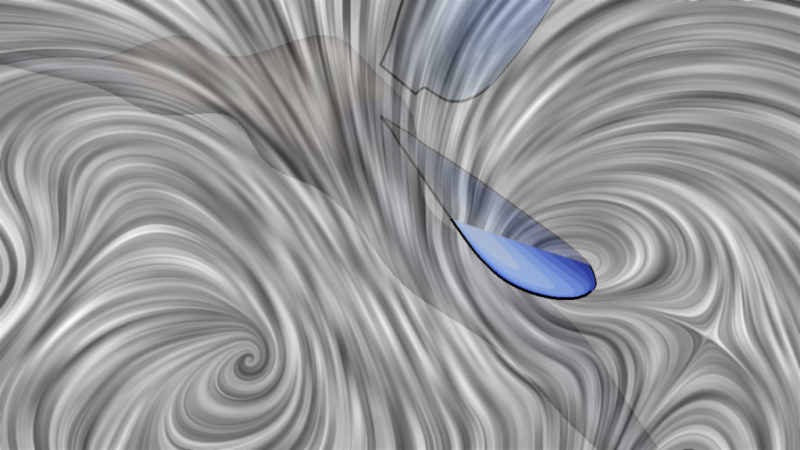
It's unmistakable. A high-pitched whine tells you you're sharing a room with a mosquito, and you are unlikely to end the evening without some itchy welts. The sound alone is enough to make you shudder.
You're not imagining things. Within the insect world, mosquitoes have a distinctive flight, with a short wing stroke and a very high frequency of wing beats. And now, researchers have figured out the physics behind their flight. They have identified two mechanisms for generating lift that had not previously been seen in any animal. "Much of the aerodynamic force that supports [the mosquito's] weight," the authors conclude, "is generated in a manner unlike any previously described for a flying animal."
The work, done by a small team of Japanese and UK researchers, involved setting up a series of eight high-speed cameras to capture every instant of a mosquito's wing flap from multiple angles. The resulting data allowed them to create a digital model of the wings as they went through a full stroke. This was then used to solve fluid dynamics equations for the air around the wings, letting the researchers track the movement of the air as the wing beat through it.
For starters, the measurements confirmed that a mosquito's wings beat at a frequency of over 700Hz. This is much faster than most other insects and explains the mosquito's distinctive whine. The other distinctive feature is that the sweep of the wing (the total angle it travels) during the wing beat is less than 40 degrees—"less than half the smallest amplitude yet measured for any hovering animal."
The models found that lift is generated by three distinct mechanisms. The first, a leading edge vortex, is common in other insects. (In fact, it's critical to the flight of the bumblebee, which was once thought to have a wing that was too small to generate the lift it clearly does.) During the downward sweep of the wing, a vortex of air is generated in front of the leading edge of the wing and then loops back over the wing. This creates an area of low pressure above the wing, providing some lift.
But this only happens while the wing is sweeping downwards. Because of the mosquito's short wing stroke, the wing doesn't beat downwards for long. Something else must be going on.
One part of that something else is a trailing edge vortex. Normally, this vortex forms at the back edge of the wing and then moves off away from it (it's said to detach from the wing). That means a trailing edge vortex doesn't generate lift. But the mosquito wing stroke is such that, as soon as the animal stops its downward stroke and reverses its wing upwards, the wing runs into the trailing edge vortex. The vortex happily reattaches to the wing, providing it some lift. Here, the short wing stroke is an advantage, because the wing spends more time with a trailing edge vortex attached.
No one has ever seen this before
Mechanism three had been postulated when people were modeling wings, but no one had ever seen it before. It has to do with what happens when the wing reaches the top of its upwards stroke and starts to reverse course downward. Here, the wing has to rotate a bit, and the central point of this rotation starts off at the leading edge of the wing, near where the wing meets the body. This rotation also creates an area of low pressure on top of the wing that adds some lift. But normally, it's gone so quickly that the lift is insignificant.
The mosquito manages to stretch this out and gets much more lift. It does this, in part, by slowly shifting the axis of wing rotation from the front of the wing to the rear. Second, the mosquito doesn't rotate the whole wing at once. While the axis of rotation starts off near the junction with the body, it moves outward toward the tip gradually. Thus, while the portion of the wing near the body has already rotated and started beating downwards, the far tip is still being drawn upwards; rotation is still going on somewhere about two-thirds of the way down the wing.
The result is that at least some part of the wing is rotating for a large percentage of the mosquito's wing beat. Thus, there's an area of low pressure providing lift somewhere on the wing for a greater fraction of the wing beat. Add in how the wing beat is very quick and short, and this generates lift for a big fraction of the overall wing beat.
Thus, the fast wing beat, while it sacrifices lift from the leading edge vortex, allows two other sources of lift to move from making negligible contributions to becoming major factors in the mosquito's flight.
The striking thing about the mosquito's method isn't the physics of the air movement; it's the exquisite wing control that's required to get so much out of a short wing stroke. That, and the fact that no other animal appears to be doing any of this. We may eventually find others, but those discoveries will do nothing to make the whine of the mosquito any less impressive or annoying.
Nature, 2017. DOI: 10.1038/nature21727 (About DOIs).
reader comments
105